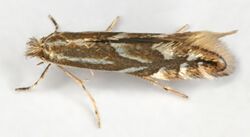Biology:Phyllonorycter coryli
| Phyllonorycter coryli | |
|---|---|

| |
| Scientific classification | |
| Domain: | Eukaryota |
| Kingdom: | Animalia |
| Phylum: | Arthropoda |
| Class: | Insecta |
| Order: | Lepidoptera |
| Family: | Gracillariidae |
| Genus: | Phyllonorycter |
| Species: | P. coryli
|
| Binomial name | |
| Phyllonorycter coryli (Nicelli, 1851)
| |
| Synonyms | |
| |
Phyllonorycter coryli, or nut leaf blister moth, is a moth of the family Gracillariidae. It is found most of Europe, except the Balkan Peninsula.
The wingspan is 7–9 mm. The forewings are golden-ochreous, often fuscous-tinged, first costal spot dark-margined posteriorly. The larva is pale yellowish; dorsal line dark green; head pale brown.[1]
The larvae feed on Corylus avellana, Corylus colurna, Corylus maxima and Ostrya carpinifolia. They mine the leaves of their host plant. They create an upper-surface silvery tentiform mine. At first, the mine remains quite flat, and has the appearance of a blotch mine. At the end, the leaf is strongly contracted. There may be several mines in a single leaf. The pupa is made in a cocoon in a corner of the mine. The frass is deposited in the opposite corner.
References
- ↑ Meyrick, E., 1895 A Handbook of British Lepidoptera MacMillan, London pdf
 This article incorporates text from this source, which is in the public domain. Keys and description
This article incorporates text from this source, which is in the public domain. Keys and description
Gallery
External links
Wikidata ☰ Q7188937 entry
 |




